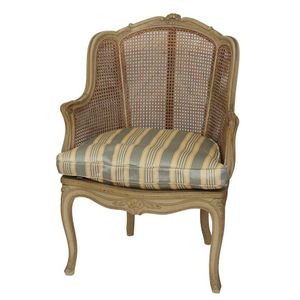Louis XV Giltwood Chairs with Carved Foliate Crest Rails
Pair of late 19th century French Louis XV style chairs, in giltwood, with carved foliate crest rails, above a shaped caned back and seat, above a carved apron on cabriole legs (2)
You must be a subscriber, and be logged in to view price and dealer details.
Subscribe Now to view actual auction price for this item
When you subscribe, you have the option of setting the currency in which to display prices to $Au, $US, $NZ or Stg.
This item has been sold, and the description, image and price are for reference purposes only.
- Giltwood - Giltwood is used to describe a gold finish on furniture and other decorative wooden items, whereby a thin sheet of gold metal, called gold leaf, is applied to the surface for decorative purposes.
Unlike gilding, where the gold leaf is applied over a coating of gesso, with giltwood the gold leaf is applied direct to the surface, or over a coat of linseed oil gold leaf adhesive.
Most gold-finished mirrors will be gilded, whereas furniture with gold highlights will have the gold applied through the giltwood method. - Foliate - Decorated with leaves or leaf-like forms.
- Cabriole Leg - The cabriole leg evolved from an elongated scroll, curving out at the knee which may or may not be carved, and forming a serpentine shape as it descends to the foot.
First introduced into English furniture in the late 17th century, cabriole legs were widely used during the Queen Anne and early Georgian periods, where they frequently terminated in a pad foot or ball and claw foot. The style has had many imitators since then. The cabriole leg was re-introduced in the mid-19th century, and is commonly associated with the balloon-back dining or drawing-room chairs made in walnut, mahogany or, in Australia, cedar. The Victorian cabriole leg, on the whole, was rather more slender than the earlier form, following the French style, which emphasized the delicacy and daintiness of the chairs they were designed to support. Cabriole legs are sometimes found on windsor chairs, especially those made during the 18th century. - Apron - A decorative wooden panel that sits underneath the top surface of a table or chair, and unites the top of the piece with the legs, running at right angles to the underside. On carcase furniture such as a chest or wardrobe, the apron sits below the drawers or doors and attaches to the legs.
On carcase furniture without legs the panel under the drawers or doors sits on the floor and is termed a plinth.
An apron can provide a decorative touch to an otherwise unadorned piece of furniture and at the same time provide structural support and strength. They can be carved or pierced and quite elaborate.
This item has been included into following indexes:
-
chairs, singles / pairs / threes, style or period
- French 949
- Louis XV 353
- Victorian, other styles 1,179
Visually similar items

A Louis XV bedroom chair with cane seat, back and sides Lime-washed timber frame.
Sold by
in
for
You can display prices in $Au, $US, $NZ or Stg.

A Louis XV style caned porter's chair, French, 19th century, well carved frame supported on fluted legs, upholstered in chartreuse green cut velvet, 146 cm high, 72 cm wide and 66 cm deep
Sold by
in
for
You can display prices in $Au, $US, $NZ or Stg.

Sold by
in
for
You can display prices in $Au, $US, $NZ or Stg.

A pair of Louis XVI style gilt wood fauteuils, upholstered in pink and sage green fabric
Sold by
in
for
You can display prices in $Au, $US, $NZ or Stg.
